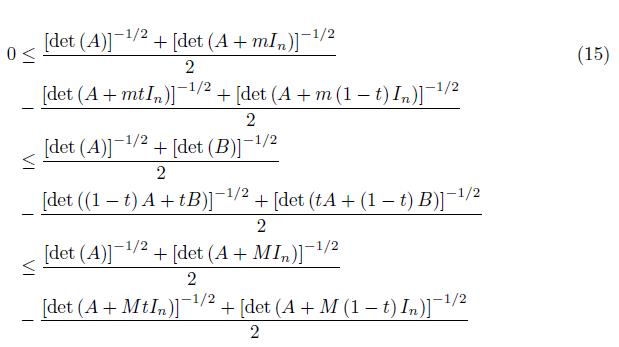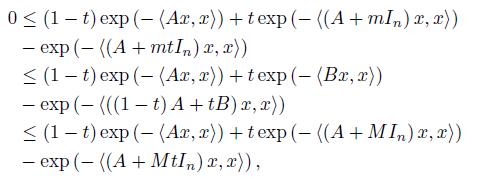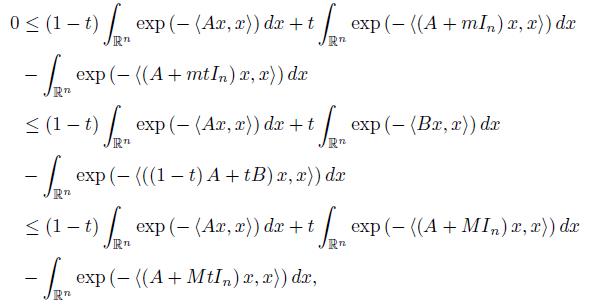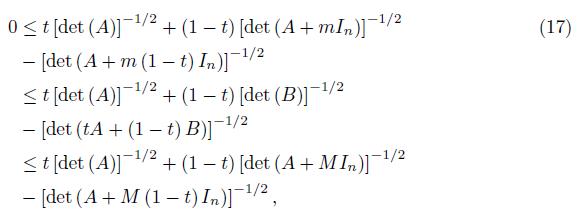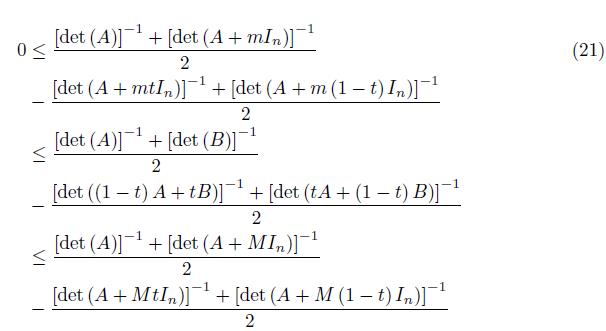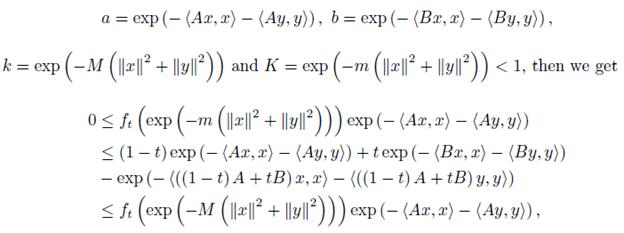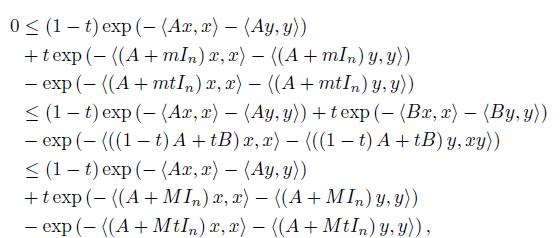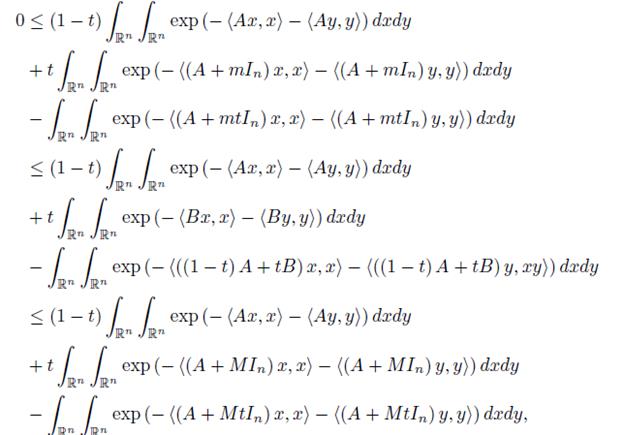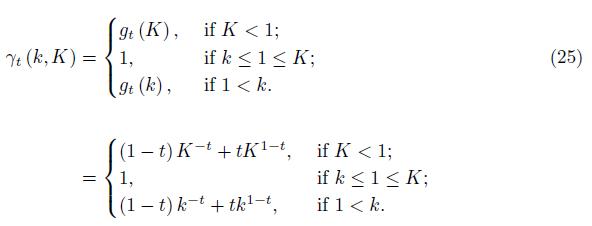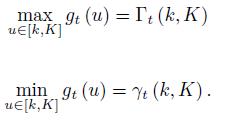1. Introduction
A real square matrix A = (αij ) , i, j = 1, ..., n is symmetric provided aij = aji for all i, j = 1, ..., n. A real symmetric matrix is said to be positive definite provided the quadratic form
 is positive for all x = (x1, ..., xn) ∈ ℝn \ {0}. It is well known that a necessary and sufficient condition for the symmetric matrix A to be positive definite, and we write A > 0, is that all determinants
is positive for all x = (x1, ..., xn) ∈ ℝn \ {0}. It is well known that a necessary and sufficient condition for the symmetric matrix A to be positive definite, and we write A > 0, is that all determinants
are positive.
It is know that the following integral representation is valid, see [1, pp. 61-62] or [11, pp. 211-212],
where A is a positive definite matrix of order n and
 · is the usual inner product on ℝn.
· is the usual inner product on ℝn.
By utilizing the representation (1) and Hölder’s integral inequality for multiple integrals one can prove the logarithmic concavity of the determinant that is due to Ky Fan ([1, pp. 63] or [11, pp. 212]), namely
for any positive definite matrices A, B and λ ∈ [0, 1] .
By mathematical induction we can get a generalization of (2) which was obtained by L. Mirsky in [10], see also [11, pp. 212]
where λj > 0, j = 1, ..., m with
 and Aj > 0, j = 1, ..., m.
and Aj > 0, j = 1, ..., m.
If we write (3) for Aj = B−1 j we get
which also gives
where λj > 0, j = 1, ...,m with
 and Aj > 0, j = 1, ...,m.
and Aj > 0, j = 1, ...,m.
Using the representation (1) one can also prove the result, see [11, pp. 212],
where the determinant det (Ars) is defined by
In particular,
We recall also the Minkowski’s type inequality,
for A, B positive definite matrices of order n. For other determinant inequalities see Chapter VIII of the classic book [11]. For some recent results see [3]-[6].
Motivated by the above results, in this paper we prove among others that, if the positive definite matrices A, B of order n satisfy the condition
for some constants 0 < m < M, where In is the identity matrix, then
for all t ∈ [0, 1] .
2. Additive Inequalities
We consider the function ft: [0, ∞) → [0, ∞) defined for t ∈ (0, 1) by
The following lemma holds.
Lemma 2.1. For 0 ≤ k < K we have
and
Proof. The function ft is differentiable and
which shows that the function ft is decreasing on [0, 1] and increasing on [1, ∞), ft (0) = 1 − t, ft (1) = 0 and the equation ft (u) = 1 − t for u > 0 has the unique solution
 .
.
Therefore, by considering the 3 possible situations for the location of the interval [k, K] and the number 1 we get the desired bounds (9) and (10).
Lemma 2.2. Assume that a, b > 0 with
 , then
, then
Proof. If u ∈ [k, K] , then by Lemma 2.1 we have
If we take
 in (12), then we get
in (12), then we get
and by multiplying with a we obtain the desired result (11).
Theorem 2.3. Assume that the positive definite matrices A, B satisfy the condition
for some constants 0 < m < M, then
for all t ∈ [0, 1] .
for all t ∈ [0, 1].
Proof. Let a = exp (− Ax, x ) and b = exp (− Bx, x ) for x ∈ ℝn. Then exp (− (B − A) x, x ) and since 0 < mIn ≤ B − A ≤ M In, hence for x ∈ ℝn,
which gives that
If we apply the inequality (11) for a = exp (− Ax, x ) , b = exp (− Bx, x ) , k = exp (−M ||x||2) and K = exp (−m ||x||2 < 1, then we get
Namely
This inequality can be written as
for x ∈ ℝn and t ∈ [0, 1] .
If we take the integral over x ∈ ℝn, then we get
for t ∈ [0, 1] .
By using the representation (1) we get
which, by the second equality in (1) gives (14).
If we replace t with 1 − t in (14), then we have
for t ∈ [0, 1] .
If we add (14) with (17) and divide by 2, then we get (15).
Inequalities for Positive Definite Matrices Via Additive
Corollary 2.4. With the assumptions of Theorem 2.3 we have
The proof follows by taking the integral over t ∈ [0, 1] in (14).
If we take the square in the representation (1), then we get
Since
hence
for A a positive definite matrix of order n and h  i is the usual inner product on ℝn.
i is the usual inner product on ℝn.
We have:
Theorem 2.5. Assume that the positive definite matrices A, B satisfy the condition (13) for some constants 0 < m < M, then
for all t ∈ [0, 1] .
Also,
for all t ∈ [0, 1] .
Proof. Let a = exp (−hAx, xi − hAy, yi) and b = exp (−hBx, xi − hBy, yi) for x, y ∈ ℝn. Then
and since 0 < mIn ≤ B − A ≤ MIn, hence for x, y ∈ ℝn,
which implies that
If we apply the inequality (11) for
Namely
for x, y ∈ ℝn and t ∈ [0, 1] .
If we take the double integral over x, y ∈ ℝn, then we get
and by making use of the representation (19).
Corollary 2.6. With the assumptions of Theorem 2.5 we have
The proof follows by taking the integral over t ∈ [0, 1] in (20).
3. Multiplicative Inequalities
We consider the function gt: (0, ∞) → (0, ∞) defined for t ∈ (0, 1) by
For [k, K] ⊂ (0, ∞) define the quantities
and
The following lemma holds.
Lemma 3.1. For 0 ≤ k < K we have
Proof. The function gt is differentiable and
which shows that the function gt is decreasing on (0, 1) and increasing on [1, ∞) . We have gt (1) = 1, limu→0+gt (u) = +∞, limu→∞gt (u) = +∞ and gt 1 = g1−t (u) for any u > 0 and t ∈ (0, 1) .
Therefore, by considering the 3 possible situations for the location of the interval [k, K] and the number 1 we get the desired bounds (11) and (12).
Lemma 3.2. Assume that a, b > 0 with
 then
then
Proof. From Lemma 3.1 we have
Namely
If we multiply these inequalities by a, then we get (26).
Theorem 3.3. Assume that the positive definite matrices A, B satisfy the condition
for some constant 0 < m, then
for all t ∈ [0, 1] .
In particular, for t = 1/2,
Proof. If 0
 , then by (26) we get
, then by (26) we get
Namely
If we apply the inequality (29) for α = exp (− Ax, x ) , b = exp (− Bx, x ) and K = exp (−m ||x|| 2 < 1, then we get
This is equivalent to
namely
for all x ∈ ℝn and t ∈ [0, 1]
Observe that
and
By taking the integral on ℝn, we get
namely, by (1)
which gives (27).
By utilizing a similar argument to the one in the proof of Theorem 2.5 we can finally state:
Theorem 3.4. Assume that the positive definite matrices A, B satisfy the condition
for some constant 0 < m, then
for all t ∈ [0, 1] .
In particular, for t = 1/2,
A complex square matrix H = (hij ) , i, j = 1, ..., n is said to be Hermitian provided
 for all i, j = 1, ..., n. A Hermitian matrix is said to be positive definite if the Hermitian form
for all i, j = 1, ..., n. A Hermitian matrix is said to be positive definite if the Hermitian form
 is positive for all
is positive for all
 .
.
It is known that, see for instance [11, pp. 215], for a positive definite Hermitian matrix H, we have
where z = x + iy and dx and dy denote integration over real n-dimensional space ℝn. Here the inner product x, y is understood in the real sense, i.e.
 .
.
On making use of a similar argument to the one in Theorem 2.5 and Theorem 3.4 for the representation Kn (·) we can state the same inequalities for positive definite Hermitian matrices H and K.


































